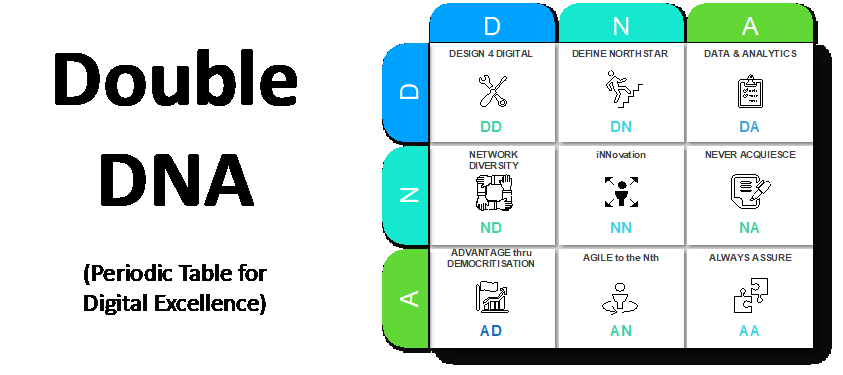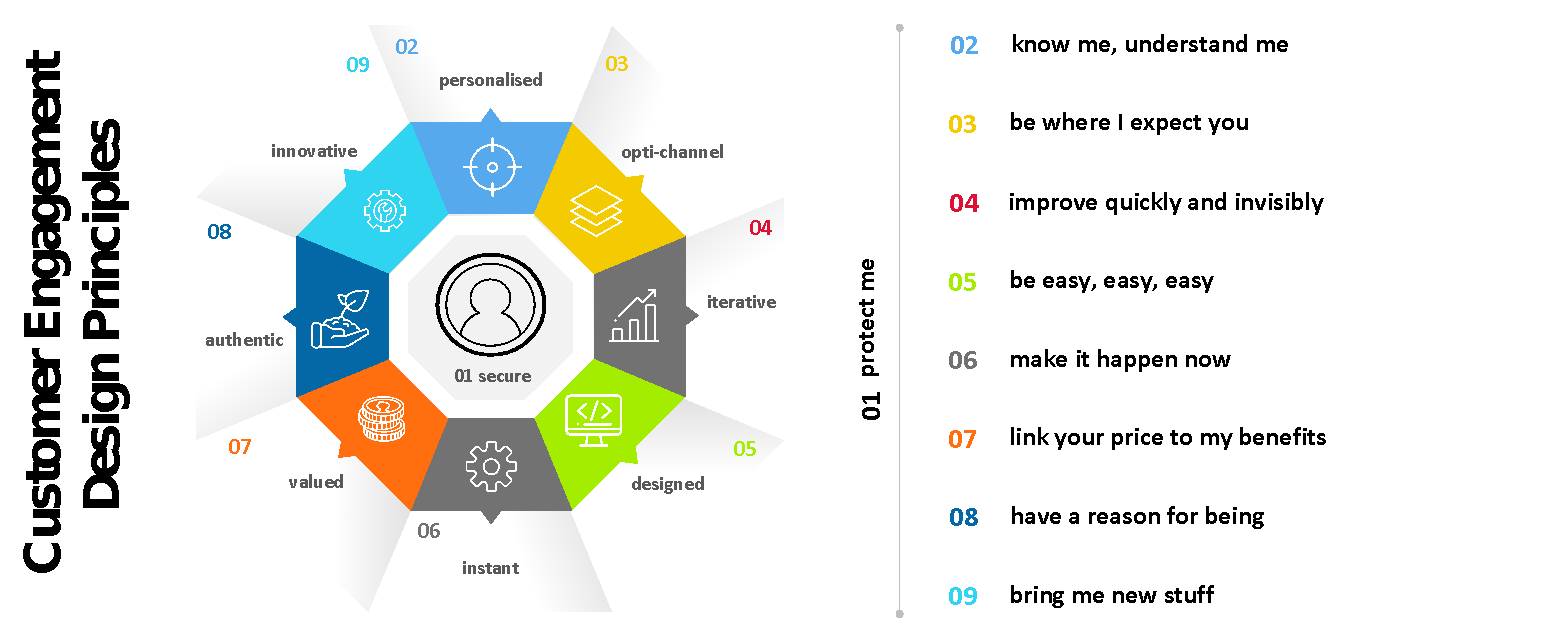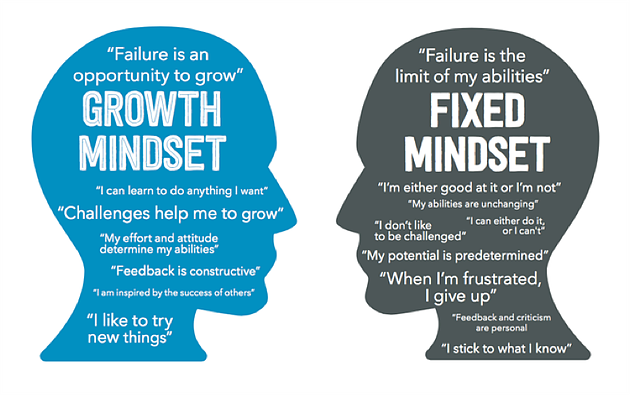The real ‘Source Code’ – : a 21st century periodic table for Digital DNA that diagnoses deep and real modern-day digital prowess from exoskeleton digital pretence
I was recently asked to pull together a strategically stimulating presentation on digital innovation for a gathering of senior folks in the financial services industry. In permeating what topics and structure to unleash from the arsenal, it struck me that by now such a seasoned cohort could well be less than enthused by a now well trotted out rendition of the ‘7 golden rules of digital transformation’ or the ‘5 necessary insights for strategic innovation’.
Surely such a prestigious gathering would deserve something better, a new perspective, a practical yet stretching view on how to be digital, not why and by which methodologies or set of principles to dictate to the folks back at the office. To me this was a call to go back to the roots or ‘Source Code’ of what it takes to win in today’s digital marketplace. In other words, look at the very essence of digital leadership, the core DNA, and talk about what it takes behaviourally and systemically.
So I started making some notes, developing out what in my experience makes organisations and leaders digitally brilliant. But I needed something to frame my thoughts – a vehicle to construct a resonating, memorable story. So I went back to the concept of DNA, looked it up and found an insightful article in Medical News Today which states “Virtually every cell in your body contains DNA or the genetic code that makes you you. DNA carries the instructions for the development, growth, reproduction, and functioning of all life. “Nice”, I thought – that could help frame what I’m getting at – being digital, not doing digital.
As I read on, memories of school textbooks sparked alive, prompted by vibrant illustrations of double-helix chromosomes celebrating the ‘ladder of life’, on which our lineage and individuality is built – what a great structure to hang my concept upon. But wait – there are 23 pairs of chromosomes in every human, each containing one DNA molecule ! I can’t expect my audience to consume 46 molecules of wisdom, if I in fact could come up with them. The plan was backfiring!
But being a strategist, I said surely there has to be a framework, a grid even, to solve this and that’s when it hit me – Double DNA. My periodic table for digital excellence.

Unravelling the strains
Let’s take a walk through the 9 core components of Double DNA for digital excellence, and as you’ll see as we unpack them, I’m boldly going to pose “how digital is your DNA”.
Design 4 Digital – the digital movement started out in channels, with the rise of the web powering alternative access to products and services, and then smartphones and their apps, exponentially increasing digital engagement. But soon after digital marketing brought the new CX hungry hordes to the front door, new digital products and services were imagined, built on digitised processes by digital workforces emancipated by digital technologies. The necessity for digital to infiltrate and power an organisation at every level is now a prerequisite. Only organisations that take a 360° approach to digitising their business can truly meet the benchmarks of digital excellence. The question is do you? You can read more about my hypothesis on Digital 360° here.
Define Northstar – in my Digital 360° hypothesis, you also read about my views that the customer is the touchstone for enabling digital transformation. A touchstone is a fervent reminder, and a re-energiser for leaders and teams navigating a tough transformation journey as they reorient from product to customer. So go back to the customer to go forward is my message. Equally and necessarily our vision needs to be forward looking, fully immersive in a purpose of meeting customer desires, and creating a better environment for all stakeholders. Our visions or ‘Northstars’ should be customer-centric and motivational. Below you’ll find a ‘starter for 10’ set of design principles for Customer Experience that I sometimes use to articulate how to articulate customer needs, but be warned – they are generic, neither brand, market nor segment specific, and every organisation nay proposition, need to develop their own.
 Data & Analytics – if you don’t believe that digital is really only the means to ‘datafy’ our economies, organisation and propositions, change that to didn’t. The advances of data science, and scientists, are accelerating post the AI winter of the latter 20th century, and as everything is being digitised, the resulting data-harnessing is moving centre stage. In fact we are seeing the Chief Analytics Officer become the new transformation centre of gravity in mature organisations, steadily taking over from the Chief Digital Officer of the 2010’s – see McKinsey’s view on this here. And in case you need serious convincing, have a read through Leftronic’s article on the 39+ Big Data Stats for 2020. It’s an eye opener, and my favourite is #28 “Data-driven organizations are 23 times more likely to acquire customers than their peers”.
Data & Analytics – if you don’t believe that digital is really only the means to ‘datafy’ our economies, organisation and propositions, change that to didn’t. The advances of data science, and scientists, are accelerating post the AI winter of the latter 20th century, and as everything is being digitised, the resulting data-harnessing is moving centre stage. In fact we are seeing the Chief Analytics Officer become the new transformation centre of gravity in mature organisations, steadily taking over from the Chief Digital Officer of the 2010’s – see McKinsey’s view on this here. And in case you need serious convincing, have a read through Leftronic’s article on the 39+ Big Data Stats for 2020. It’s an eye opener, and my favourite is #28 “Data-driven organizations are 23 times more likely to acquire customers than their peers”.
Network Diversity – platformisation, enabled by the internet, but really a reimagination of the marketplace by unbounded innovators, has spurred the era of Open. An era where the confines of vertically integrated businesses have now become weak when once strong – proprietary value chains have become chains to growth. Customers now demand value add, extended services to compliment the core product. Operations need to leverage outsourcing and diversification. And CFO’s need new revenue streams. MIT Sloan published a great article in 2007 on Open Business Models – it was mature then, and still just as relevant today. The question is how open are you to using the network to diversify your services, revenue and risks?
Harvesting the external network is not the only reflection under this strain – we should talk about diversity on the inside, and hold the mirror up to establish how well your business, from the board to the front line, represents your customers and your market. If there is a mismatch, you and your organisation are leaving ‘bread on the table’ so to speak – this metric-driven piece from Deloitte on the drivers and value of a diverse and inclusive workplace should help spur you to take a fresh perspective, should you deep down know you need one!
iNNovation – Seeing as I developed Double DNA for a group of corporate leaders, I wanted to speak about Intrapreneurship, albeit I believe the art of intrapreneurialism is apt for businesses large and small. Sustainable business school founder, Gifford Pinchot III, coined the term intrapreneur in 1978 and defined it as “Dreamers who do. Intrapreneurs are employees who do for corporate innovation what an entrepreneur does for his or her start-up.” Being an Intrapreneur is the practise of innovation at its most complex. The ability to dream of new propositions and value exchanges, coupled with the discipline to execute against the tide of conformity, and the nous to apply innovation activity to the strategic and operational demands of the organisation is a tightrope many attempt to traverse, and not all succeed in crossing.
This short article from HBR cites the basic lessons, the essence being “hiring a few talented individuals and hoping for the best, without changing anything about your organization, won’t cut it”. For a deeper perspective on the duality of innovation and move beyond the myths prescribed, check out this deeper and more recent piece from HBR on the hard truth about innovation cultures and consider your level of intrapreneurialism.
Never Acquiesce – I saw a quote once – “there’s no point looking back, you’re not going that way”. Don’t get me wrong, reflection is important and never wasted, but can be an anchor if overindulged. Purpose driven leaders, those who achieve the greatest of feats, look forward and believe in limitless growth. This is beautifully captured in Carol Dweck’s Growth Mindset, which is a ‘must’ for both personal and professional pursuits in the modern age, a summary of which you can read here and includes a TedTalk from the great woman herself.
Sataya Nadel is probably one of the foremost advocates of Growth Mindset, having emboldened Microsoft with the philosophy of taking charge. You can read more about Nadel’s pursuits in this article. As for results, Microsoft’s share price has tripled in his time there, which some would say was the most challenging for tech stocks, so perhaps there’s something in this one unless you can counter that kind of growth story.

Advantage thru Democritisation – just think about the most common brands that trip of the tongue of every strategy prophet illustrating the business model leaders of today. Google, Uber, Netflix – the list goes on, and all indeed have managed to build extraordinary audiences and business opportunities in their own ways, but all have one thing in common. They have in one way or another managed to create or play a significant role in the Sharing Economy. They have democratised products and services and created new streams of revenue and audience by maximising access and minimising costs. These 2 vectors, when great User Experience (UX) has been applied, are at the core of what we’ve come to define as great Customer Experience (CX).
A recent and bold foray into the democratisation of money was unveiled by Facebook’s Libra White Paper last year. Their global reach and questionable leverage of personal data has spooked the establishment, and while I have no doubt Facebook’s project will be challenged, I would recommend getting past the noise, and read the paper to understand the admirable intent and downstream consequences of such seismic developments that will surely follow in one form or another. A small point, which takes up but 2 lines at the top of page 9, but caught my eye is the enabling topic of digital identity. I believe the coming years will see, and require, democratised digital identity as a prerequisite for the next wave of the industrial evolution – this topic I believe is one to watch, or one to make happen.
Agile to the Nth – agility is a corporate and leadership mindset, and a way of organising and iteratively developing just as much as it is a methodology for proposition and software development. Agility requires organisational qualities such as adaptiveness revolving around core competencies according to Landor’s Agility Paradox, which studies the underpinning competencies of the most agile brands. But the 7 S’s proclaimed by this Forbes article (Slack, Speed, Simplicity, Subsidiarity, Surprise, Serendipity and Singularity) is a richer lens to gaze through and unpick the traits of the agile organisation, built for longevity and self-determining destiny. Again the question – how do you and your organisation fare?
Always Assure – last but not least, and in fact foundational is trust and security. Leaders that march their organisational troops forward in the battle of the digital market would do well to ask the question – how many events, papers and perspectives on protecting our customers and our cyber defences have we consumed in the recent past. Leaders would do well to ensure that assurance receives the necessary attention. Pick from the myriad of resources, including Accenture’s perspectives, on the sophistication and strength of bad actors – you’ll see this is no time for complacency.
Benchmark
So how does one benchmark their digital prowess – well I don’t believe they should, can or need to! I am of the view that given digital is a 360° thing, that customer-centricity and the Northstar need to be unique, and given the rapid nature of change that is abound, any attempts to ‘score’ oneself or one’s organisation is futile and would be effort better spent on progress as opposed to reflection.
What I would attest to is a test – testing are we in fact being digital or just trying to do digital. Testing how do we fare out against a model such as Double DNA. And testing are we doing enough – are we going fast enough, far enough and faithfully towards a state of ever-evolving digital excellence.
In the words of Aristotle “Excellence is never an accident. It is always the result of high intention, sincere effort, and intelligent execution; it represents the wise choice of many alternatives – choice, not chance, determines your destiny”.

